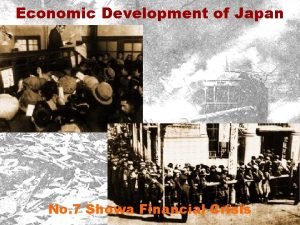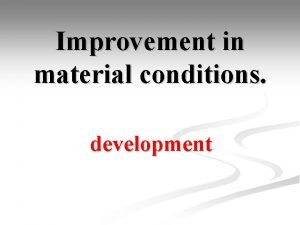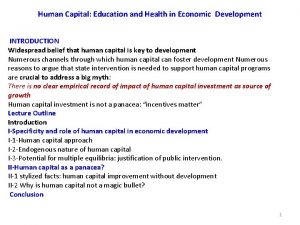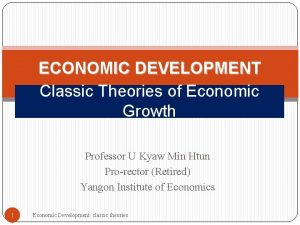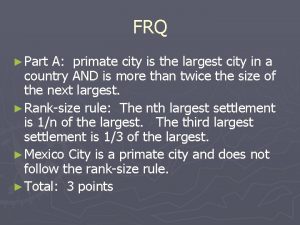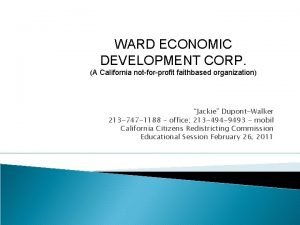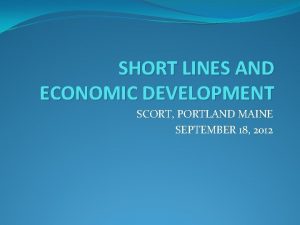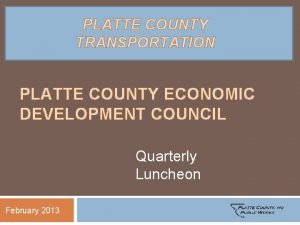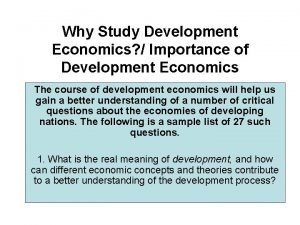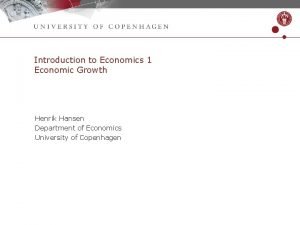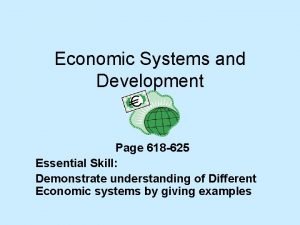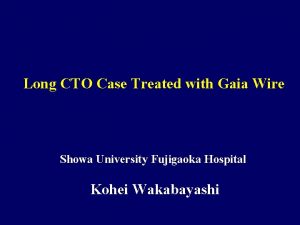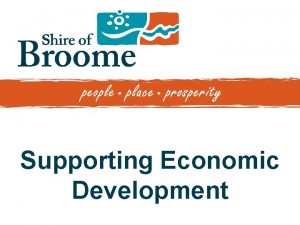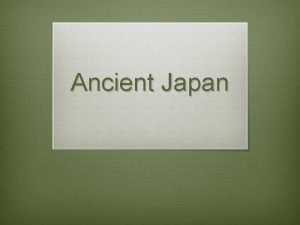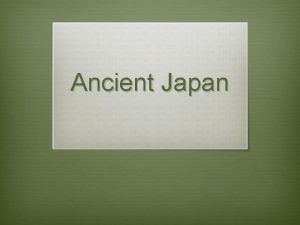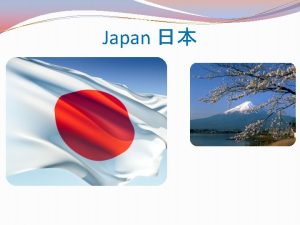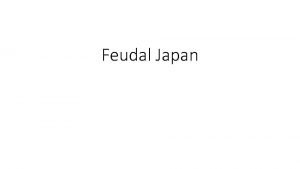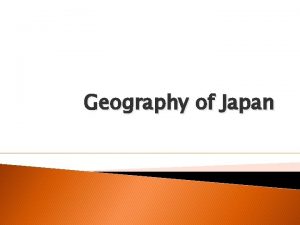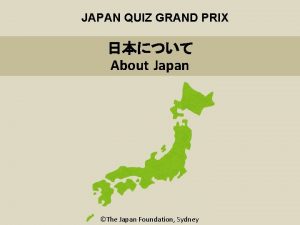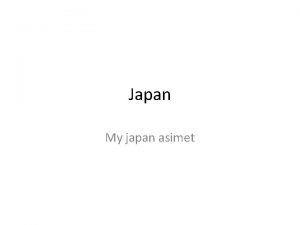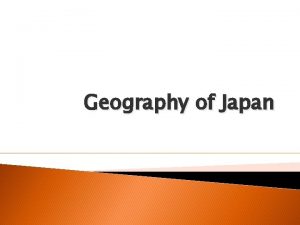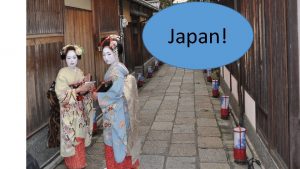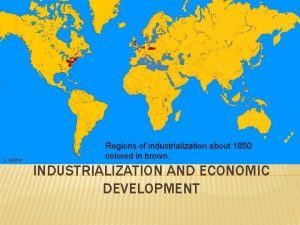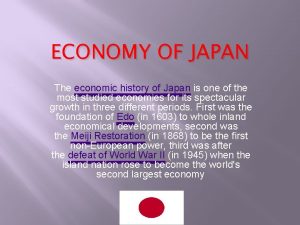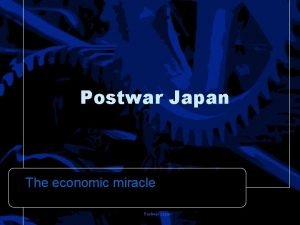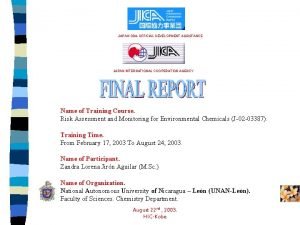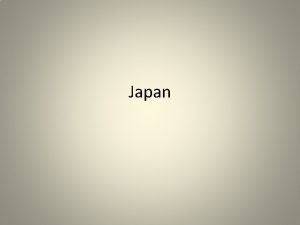Economic Development of Japan No 7 Showa Financial



























- Slides: 27

Economic Development of Japan No. 7 Showa Financial Crisis

The Showa Financial Crisis, 1927 Kamekichi Takahashi & Sunao Morigaki, History of Showa Financial Crisis, 1968 (reissued 1993). Part I—Fundamental causes of 1927 financial crisis Pre-modern nature of the banking system Accumulation of fundamental causes (bubble & burst) Economic damage after Great Kanto Earthquake Damage to businesses and banks after 1920 Depression Part II—Immediate causes and development Immediate causes/breakout/solution Part III—Economic impact and historical significance Impact on financial structure and market True cause of Showa Financial Crisis

Policy Issues for Consideration p When a large bubble collapses (1920), should weak banks & businesses be rescued or made to disappear? p What should be done when bad debt continues to rise with no prospect of automatic solution (1920 -27)? • Inject public money to write off debt? • How can government avoid criticism that big businesses are helped with taxpayers’ money? • Or accept a financial crisis and concentrate on post-crisis restructuring? p What measures are needed to stop bank runs, if they occur (1927)? p What should be done when bank runs are over (after 1927)?

Timeline of Japanese Banking System Number of Banks from Meiji to Prewar Showa American style banking (private banks to issue money) Bank of Japan established, 1882 Ordinary bank system (only central banks to issue money) Bank runs of 1927 Great Kanto Earthquake, 1923 Industrial revolution (textile) Fiscal pressure WWI export boom Coverage: "national" banks, private and ordinary banks and special banks. Source: Bank of Japan (Historical Statistics of Japan, vol. 3, p. 166) Heavy industries Reces- Depression War

Causes of the Showa Financial Crisis According to Takahashi & Morigaki Fundamental causes (more important) • Internal problems in the banking system (kikan ginko). • Rescuing weak businesses generously without serious restructuring after the bubble burst. • The 1923 earthquake and exchange rate instability further weakened Japanese economy. Immediate causes • Political fights over the unsettled earthquake bills. • Minor misstatement by Finance Minister Kataoka.

“Fundamental causes of the Financial Crisis were as follows: 1/ Despite the fact that Japan’s economy grew strongly in quality and quantity during WW 1; 2/ The banking system remained pre-modern with many defects; 3/ As a result, after excessive speculation ended in 1920, both government and private businesses made the mistake of implementing only temporary measures hoping that the next boom would bail them out. But the economic malaise was deeply rooted, and temporary measures only made things worse. In addition, the 1923 earthquake and exchange rate instability further damaged the economy. Profits fell, bad debt rose, and most banks were on the verge of collapse. ” (Takahashi & Morigaki, 1993, p. 7)

Pre-modern Banking System • 1927 Banking Crisis was caused by Japan’s internal problems, not by global economic shocks. • Japanese banks were too small and too many. They lent to too few and too carelessly. --Bank owners also run other businesses and used bank money to finance them. --Lending was concentrated on one (or a few) company based on personal connections. --No sense of management responsibility and no external monitoring (especially rural banks). --Bank owners were wealthy men who did not actually supervise banking business (especially rural banks).

Kikan Ginko Visualized A respected & influential man in the community OWN DEPOSIT Local residents OWN LOAN BANK COMPANY No disclosure of bank or company performance No prudential regulation or deposit insurance Concentration of bank lending to one or a few companies

P. 114 Kikan Ginko (機関銀行 institutional banks) Collusion between bank & business • In the 1890 s, as demand for industrial funds rose, many small private banks were set up. Such banks may have been necessary for early industrialization. But they lent to only one or few firms. • By the pressure of the Banking Association, loan ceiling on one borrower (max. 10% of bank capital) was repealed in 1895. • Mo. F tried to revise the Banking Act to strengthen supervision and reduce loan concentration, but the Banking Association resisted. Number of banks Dualism in banking Large zaibatsu banks Group companies Small kikan ginko Local SMEs Cf. In 2017, the number of Japanese banks was 139 (plus 53 foreign bank branches)

WW 1 Bubble and Burst • WW 1 boom greatly increased fund demand --Some large banks tried to modernize management --Many kikan ginko lent to narikin for speculation --Total number of banks remained about the same • Speculation fever continued in 1919 -1920 • 1920—beginning of recession: stock market fell, prices plummeted, credit crunch began. Bankruptcies—Mar (7) Apr (45) May (106), Jun (127) Bank runs— 169 (21 closed), Apr-Jul 1920

Policy Response in 1920 • Joint statement of Chambers of Commerce--“Government should supply sufficient funds and lower interest rates to overcome short-term difficulty. ” • Prime Minister Hara--“Credit crunch is a temporary phenomenon; stability will return sooner or later. ” • Finance Minister Takahashi--“Crisis is the result of overoptimistic expansion and speculation during War. ” • BOJ Governor Inoue--“This is a reaction to the previous boom. Bold restructuring is necessary. Each business must make effort; do not just ask for help. ” Actual policy response was generous assistance

Inability to Repay: Two Types There are two types of inability to repay which are fundamentally different and require very different solutions. Liquidity problem—out of cash temporarily; if one waits long enough the money will be paid back (budget constraint is secure) Solution: debt rescheduling (delayed payments) Solvency problem—unable to pay now or in future; waiting will make the problem even worse (budget constraint is breached) Solution: debt forgiveness (cancellation) It is often difficult at the beginning to tell whether the problem is illiquidity or insolvency. Illiquidity is first assumed, but later insolvency is admitted. Solution normally proceeds from debt rescheduling to debt forgiveness.

Rescue Measures by Bank of Japan, 1920 • Infusion of bank reserves (35 banks, 109 mil yen) • Supply liquidity forex banks (3 banks, 50 mil yen) • Loans to targeted industries through their banks (sugar, wool, cotton, chemicals, steel, machinery, paper, power, shipbuilding, textile, railroad, etc; 360 million yen) This caused: 1/ Business dependency on BOJ rescue measures 2/ Political connection became important in obtaining rescue “Easy rescue in 1920 led to ballooning of banks’ bad debt, but authorities continued to avoid needed business restructuring for fear that they would be criticized of previous inaction or subsequent shock. This became the “Cancer in the Business Community. ” The government could not cure the cancer and invited the brutal natural force, namely Great Depression, to solve the problem. ” (Takahashi & Morigaki, 1993, p. 77)

Suzuki Shoten & Bank of Taiwan Naokichi Kaneko, Suzuki manager Million yen P. 117 BOT Assets & Liabilities Suzuki & Co. Bubble ends Earthquake --BOT and Suzuki built relations through camphor & sugar trade. --During WW 1, Suzuki bought up steel, ships, wheat; sold ships together with cargo, etc. and became the top trading firm in Japan. --After WW 1, Suzuki debt turned bad. --Loans to Suzuki rose sharply after bubble burst (kusare en— unhappy but inseparable relationship) --Suzuki and BOT expected government bailout (“too big to fail”)

Balance Sheet of the Bank of Taiwan (just before the banking crisis, 1926) Assets Liabilities Other loans & assets Unpayable loans to Suzuki Shoten (rolled over & growing) Deposits Call money (very shortterm borrowing from other commercial banks) Pulled out as soon as confidence is lost Loan from Bank of Japan Will BOJ continue to lend to BOT forever?

PP. 114 -15 Two More Blows to Japanese Economy Great Kanto Earthquake, 1923 100, 000 dead; 200, 000 houses burnt or destroyed Loan recovery problem, deposit withdrawal, credit freeze Earthquake bill problem (Seisho laundered bad debt) Yen Fluctuation Businesses criticized forex speculation (“high yen causes deflation”) Agreed policy goal was “Return to Old Parity” ($1=2 yen) Business restructuring & tight budget were considered necessary USD/ 100 yen

Earthquake Bill Problem Government (Taxpayers’ money) Bad bills accumulate Bank of Japan Cash (less interest) CB Cash (less interest) Re-discounting Commercial bills CB Commercial bill (promise to pay) Product delivery (Later) Bad bills accumulate CB CB CB Commercial banks Discounting Business firms To prevent liquidity freeze, BOJ re-discounted bills without quality check in quake-affected area. Some banks/firms took advantage of this & cashed bad bills unrelated to the quake.

Earthquake Bill Problem PP. 115 -16 • Bo. J accumulated bad debt by rediscounting earthquake bills (431 m yen, of which 100 m yen deemed bad). Banks also held un-rediscounted bad debt. • Government’s proposed Earthquake Bill Laws (1) 100 m yen forgiven (Gov’t gives bonds to BOJ) (2) Max 170 m yen rescheduled (banks borrow from Gov’t for 10 years; receive business partners’ repayments to pay back this debt, government bonds used as collateral) • Parliamentary debate in early 1927 --Seiyukai Party criticized political intention of Kenseikai government (bailing out big businesses) --Data gradually revealed, BOT/Suzuki debt size reported

Three Waves of Bank Runs in 1927 PP. 116 -120 • First Wave (March)—FM Kataoka misspeaks • Second Wave (March)—BOT refuses to make any more loans to Suzuki • Third Wave (April)—BOJ refuses to lend to BOT; Privy Council rejects imperial edict to protect BOJ assets; BOT closes. Nationwide bank runs Government response Wakatsuki Cabinet (Kenseikai) falls, Tanaka Cabinet (Seiyukai) inaugurated. FM Takahashi immediately imposes 3 week moratorium on debt repayment (Apr. 22 - May 12) which ends bank runs

Aftermath of the 1927 Bank Run • 36 banks closed (but not BOT). One year later, they were reopened (15), merged (8), bankrupted (5), or in restructuring process (1). • Depositors often resisted restructuring of closed banks for fear of deposit loss (only 50 -70% recovered). • Special laws were passed for liquidity injection and BOJ loss compensation (max 500 m yen). This created liquidity glut, lower interest rates, and bailout of unrecoverable debt at a few banks (6). • The banking sector was restructured, but real growth and the production sector (firms) were not affected very much.

Mil. yen Bank Loans PP. 120 -21 Bank Deposits 5 banks 38. 3% 5 banks 29. 6% • Five largest banks—Mitsui, Mitsubishi, Sumitomo, Daiichi, Yasuda • Depositors shifted deposits to large banks, causing excess liquid and low interest rates • Small rural banks shrank or disappeared, causing shortage of SME loans.

Special Topic: A New Macroeconomic Problem under Financial Globalization • In 2007 -08 and 2010 -11, global commodity inflation and high capital mobility caused large foreign exchange inflows to many countries (interrupted by the Lehman Shock). • Receiving too much foreign exchange inflow relative to GDP causes inflation, consumption boom, construction boom, property speculation, asset bubbles, etc. • In a financially integrated world, many developing countries are prone to the cycles of excessive capital inflows, overheating, and currency overvaluation. • This is a new macro management problem different from the traditional one caused by fiscal & monetary expansion.

Foreign Fund-driven Overheating & Bubble Many countries faced this problem around 2005 -08: Large export earnings from extractive resources (“Dutch Disease” “Curse of Natural Resources”) Russia, Kazakhstan, Mongolia, UK, Nigeria, Zambia, South Africa, Botswana, Mauritania, Angola… Other large inflows (“Curse of Foreign Money” such as export receipt, remittances, FDI, ODA, military aid, bank loans, stocks & bonds, etc. ) China, Vietnam, UAE, UK, (Ethiopia? ) Large fund inflow (up to 20 -30% GDP) Increase in money supply & credit Consumption & construction booms, asset bubbles, inflation, trade deficit, currency overvaluation, rise in foreign reserves

Vietnam: Overheating 2007 & 2011 • Large inflows of remittances, FDI, ODA, securities investment • Bank lending rose sharply and “conglomerates” invested aggressively in property in 2007 • Another inflation surge in 2011 • Vietnam vs. Japan 1927: (i) capital inflow boom vs. export-led boom; (ii) no increase in manufacturing capability in Vietnam’s bubble

Ethiopia: High Inflation in 2008 Annual Changes in the Consumer Price Index % 100 8080% Total Average Y-to-Y 6060% Y-to-Y 4040% 2020% 00% -20% 2002 2003 2004 2005 2006 2007 2008 2009 Source: IMF/WB joint presentation to the Ethiopian Government, Addis Ababa, April 2009.

Nontradables (construction, trade, real estate) Tradables (% of GDP) Imported consumption goods Foreign Savings = CA deficit Domestic manufactured goods Domestic Savings

IMF/WB Advice to Ethiopia (Apr. 2009) • Short-term stabilization measures and longer-term structural measures must be combined. • Adopt more flexible exchange rate management. • External financial assistance is also required. • Closely monitor risks to the financial system. Alternative View (Ohno) • Overheating is often caused by too much purchasing power injected from outside, not traditional monetary/fiscal expansion. • Proper responses: (i) mitigate private sector overheating by moderately tight fiscal & monetary policy; (ii) regulate and monitor capital inflow & real estate loans;(iii) detect and mitigate asset bubbles and rich-poor gaps, if they occur. • Currency overvaluation is the result, not the cause of overheating. • If too much receipt of ODA is part of the cause, donors also bear responsibility.
 Showa financial crisis
Showa financial crisis Showest meaning
Showest meaning Economic growth vs economic development
Economic growth vs economic development Growth and development conclusion
Growth and development conclusion Lesson 2 our economic choices
Lesson 2 our economic choices Japan's principal asset in promoting development is
Japan's principal asset in promoting development is Non financial motivators
Non financial motivators Wake county economic development
Wake county economic development Economic social development
Economic social development Northern waterfront economic development initiative
Northern waterfront economic development initiative Human capital education and health in economic development
Human capital education and health in economic development Economic social development
Economic social development Classic theories of economic development: four approaches
Classic theories of economic development: four approaches Primate city frq
Primate city frq Canadian community economic development network
Canadian community economic development network Ward economic development corporation
Ward economic development corporation Portland maine economic development
Portland maine economic development Platte county economic development
Platte county economic development Heather candler
Heather candler Vietnam socio-economic development strategy for 2021-30
Vietnam socio-economic development strategy for 2021-30 Nature of economic development
Nature of economic development Obstacles to economic development
Obstacles to economic development Georgia academy for economic development
Georgia academy for economic development Economic growth and development
Economic growth and development California association for local economic development
California association for local economic development Ida bastiaens
Ida bastiaens Defination of economic development
Defination of economic development Role of government in economic development
Role of government in economic development
